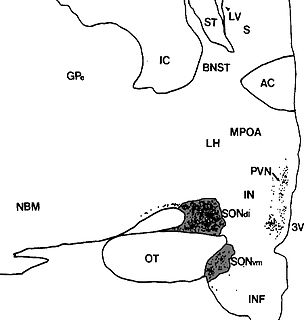An antidiuretic is a substance that helps to control fluid balance in an animal's body by reducing urination, [1] opposing diuresis. [2] Its effects are opposite that of a diuretic. The major endogenous antidiuretics are antidiuretic hormone (ADH; also called vasopressin) and oxytocin. Both of those are also used exogenously as medications in people whose bodies need extra help with fluid balance via suppression of diuresis. In addition, there are various other antidiuretic drugs, some molecularly close to ADH or oxytocin and others not. Antidiuretics reduce urine volume, particularly in diabetes insipidus (DI), which is one of their main indications.

A chemical substance is a form of matter having constant chemical composition and characteristic properties. It cannot be separated into components by physical separation methods, i.e., without breaking chemical bonds. Chemical substances can be simple substances, chemical compounds, or alloys. Chemical elements may or may not be included in the definition, depending on expert viewpoint.
Fluid balance is an aspect of the homeostasis of organisms in which the amount of water in the organism needs to be controlled, via osmoregulation and behavior, such that the concentrations of electrolytes in the various body fluids are kept within healthy ranges. The core principle of fluid balance is that the amount of water lost from the body must equal the amount of water taken in; for example, in humans, the output must equal the input. Euvolemia is the state of normal body fluid volume, including blood volume, interstitial fluid volume, and intracellular fluid volume; hypovolemia and hypervolemia are imbalances. Water is necessary for all life on Earth. Humans can survive for 4 to 6 weeks without food but only for a few days without water.

Animals are multicellular eukaryotic organisms that form the biological kingdom Animalia. With few exceptions, animals consume organic material, breathe oxygen, are able to move, can reproduce sexually, and grow from a hollow sphere of cells, the blastula, during embryonic development. Over 1.5 million living animal species have been described—of which around 1 million are insects—but it has been estimated there are over 7 million animal species in total. Animals range in length from 8.5 millionths of a metre to 33.6 metres (110 ft) and have complex interactions with each other and their environments, forming intricate food webs. The category includes humans, but in colloquial use the term animal often refers only to non-human animals. The study of non-human animals is known as zoology.
Contents
The antidiuretic hormone class includes vasopressin (ADH), argipressin, desmopressin, lypressin, ornipressin, oxytocin, and terlipressin. Miscellaneous others include chlorpropamide and carbamazepine.

Vasopressin, also called antidiuretic hormone (ADH), arginine vasopressin (AVP) or argipressin, is a hormone synthesized as a peptide prohormone in neurons in the hypothalamus, and is converted to AVP. It then travels down the axon of that cell, which terminates in the posterior pituitary, and is released from vesicles into the circulation in response to extracellular fluid hypertonicity (hyperosmolality). AVP has two primary functions. First, it increases the amount of solute-free water reabsorbed back into the circulation from the filtrate in the kidney tubules of the nephrons. Second, AVP constricts arterioles, which increases peripheral vascular resistance and raises arterial blood pressure.

Desmopressin, sold under the trade name DDAVP among others, is a medication used to treat diabetes insipidus, bedwetting, hemophilia A, von Willebrand disease, and high blood urea levels. In hemophilia A and von Willebrand disease, it should only be used for mild to moderate cases. It may be given in the nose, by injection into a vein, by mouth, or under the tongue.

Ornipressin is a vasoconstrictor, haemostatic and renal agent.







